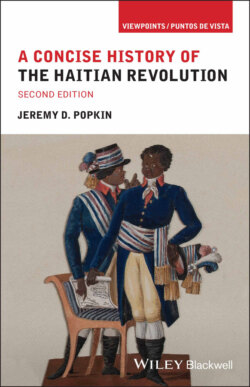Читать книгу A Concise History of the Haitian Revolution - Jeremy D. Popkin - Страница 17
The Free People of Color
ОглавлениеWhites shared the cities with enslaved blacks and with members of the colony’s third racial group, the free people of color. As in the countryside, enslaved laborers did most of the physical tasks in the cities, loading and unloading ships, working in the building trades, and caring for their masters’ households. Enslaved urban workers enjoyed greater freedom than the more numerous laborers on the plantations. Masters often taught them artisanal skills and then let them hire themselves out, in exchange for a share of their earnings. Rather than being organized into work gangs, they could often circulate on their own, and the fact that it was difficult to distinguish enslaved blacks from free persons allowed runaway marrons to blend into the city population. The urban black population would show itself less eager to participate in the insurrection that began in 1791 than the enslaved blacks on the plantations.
Enslaved urban blacks tolerated their situation because they hoped to join the population of free people of color. This third racial category among the colony’s population had begun to develop soon after enslaved blacks were imported to the island. Many, but not all, of the free people of color were the offspring of sexual relationships between white masters and enslaved black women: throughout the colony’s history, there had always been many more white men than white women willing to leave Europe for the rigors of colonial life. White men routinely exploited enslaved black women for their sexual pleasure. Although the relationships between white men and women of African descent were profoundly unequal, white men often granted freedom to women who bore themchildren; the Code Noir explicitly authorized this practice. White women often resented their husbands’ involvement with women of color; in 1791, a French official had to intervene when a jealous white wife physically attacked an enslaved woman in whom she decided her husband was taking too much interest.8
Populations of free people of color developed in all the American colonies, but in the course of the eighteenth century the group in Saint-Domingue came to be larger and more influential than in any of the other Caribbean colonies. Those free people of color who were descended from white fathers often inherited property, including enslaved blacks. Less averse to hard work than the whites, and less tempted by the prospect of leaving the colony for France, they were often more economically successful than the Europeans. Free people of color were essential to the running of the colony. Companies of free men of color were recruited to form the maréchaussée or rural police, used to hunt down runaway slaves, and entrepreneurs from this group ran many of the colony’s small businesses. White men sought out free women of mixed race, who legend claimed were more skilled at the arts of sex than whites; white women often complained that European men preferred their mixed-race rivals. Sex was not the only reason why white males linked themselves to these women, however. It was not uncommon for white men to leave the management of their property to energetic free women of color, known as menagères, who might or might not also be their mistresses; many of these women became the founders of prosperous families and sought to guide their children into advantageous marriages with other members of the free colored group or even with white men willing to cross the color line in order to improve their economic situation. Like the children of white couples, some children from mixed-race families were sent to France for their education.
As their numbers and wealth increased – by 1789 official statistics showed 28,000 free people of color in Saint-Domingue, almost as many as the 30,000 whites – members of this group increasingly resented laws that condemned them to second-class status. In 1685, the Code Noir had specified that freed blacks had “the same rights, privileges, and liberties enjoyed by persons born free,” and throughout the early part of the eighteenth century, there was little discrimination against them and their descendants in the colonies. From the 1760s onward, however, official policy and white colonists’ attitudes became increasingly prejudicial toward the free people of color. The French government calculated that maintaining a clear separation between whites and non-whites would prevent the colony’s free population from uniting to resist metropolitan authority. A series of laws attempted to limit new manumissions and banned free people of color from entering a long list of professions, including medicine and law, or from wearing fancy clothing and jewelry. Notaries drawing up legal documents had to use specific terms to identify them, and they were forbidden to use the family names of their white ancestors. In practice, many of these laws were often ignored, but free men of color were excluded from all government posts and from commanding military units. When the French Revolution broke out, they would be quick to seize on its promises of liberty and equality to demand the abolition of these restrictions.
